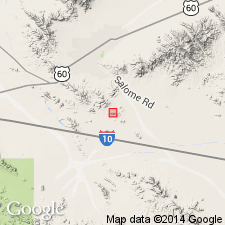
- Usage in publication:
-
- Hovatter volcanic unit
- Modifications:
-
- First used
- Dominant lithology:
-
- Andesite
- Dacite
- Rhyodacite
- Sandstone
- AAPG geologic province:
-
- Basin-and-Range province
Summary:
First published use as a unit in the Harquar formation (first used, informal) in the Harquar plate in the Little Harquahala and western Harquahala Mountains, La Paz Co, AZ, Basin-and-Range province. Intent to name, source of geographic name, designation of a type not stated. Overlies the basal conglomeratic sandstone of the Harquar formation. Upper contact is a fault contact with the conglomerate of the Harquar. Stratigraphic section. Geologic map. Consists of volcanic flows, hypabyssal intrusive rocks, tuff, and volcaniclastic sedimentary rocks. Most common rock type is massive, green-gray, very fine grained andesite or dacite, flow-banded biotite-hornblende rhyodacite, and purple or gray, massive quartz-feldspar +/-biotite dacite to rhyodacite. Original intrusive or extrusive nature of these rocks has been obscured by recrystallization and alteration. Tuff? occurs as lenses. Some bedded volcanic-lithic sandstone locally interbedded with the flows. Grains in the sandstone are well rounded suggestive of eolian origin. Age assigned to Harquar is Middle to Late Jurassic. [Age of Hovatter not specifically stated.]
Source: GNU records (USGS DDS-6; Denver GNULEX).
For more information, please contact Nancy Stamm, Geologic Names Committee Secretary.
Asterisk (*) indicates published by U.S. Geological Survey authors.
"No current usage" (†) implies that a name has been abandoned or has fallen into disuse. Former usage and, if known, replacement name given in parentheses ( ).
Slash (/) indicates name conflicts with nomenclatural guidelines (CSN, 1933; ACSN, 1961, 1970; NACSN, 1983, 2005, 2021). May be explained within brackets ([ ]).

